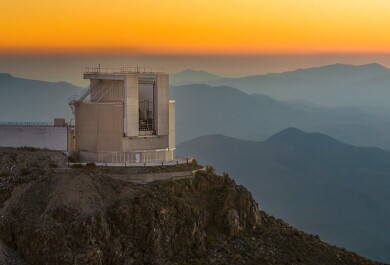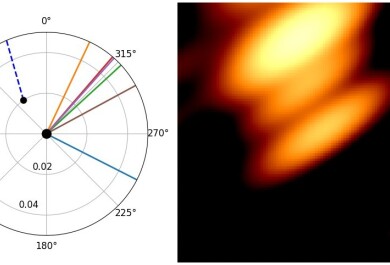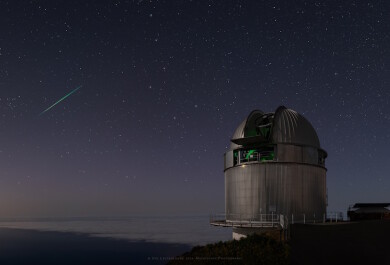The department of Physics and Astronomy at the University of Turku is a partner in the international Gravitational-wave Optical Transient Observer (GOTO) project, which will play a key role in shepherding in a new era of gravitational wave science. The GOTO observatory is made up of two identical telescope arrays on opposite sides of the planet that will track down sources of gravitational waves resulting from violent cosmic events that create ripples in the fabric of space-time itself.
Made possible by an international consortium of ten institutes, the GOTO facility consists of two nodes, one in each hemisphere, and with an identical array of telescopes. The aim is to hunt for the elusive optical counterparts of gravitational wave events.
Ripples in space-time
Gravitational waves, originally predicted by Albert Einstein, are caused by some of the most violent and energetic processes in the Universe. They arise when two neutron stars or black holes collide and merge. Gravitational waves were detected directly for the first time in 2015. Neutron stars and black holes are themselves produced in stellar explosions, known as supernovae, which is an area of active research at the University of Turku.
Since 2015, there have been many detections of gravitational waves, but observatories can only measure the effects of the gravitational wave as it passes through our local patch of space time, making it difficult to track down the source’s point of origin. It would be like knowing that a lorry has passed, by feeling the rumble in a road’s surface and trying to work out where it came from based on that alone.
Needle in a haystack
Any ‘visual’ cues resulting from a gravitational wave event fade away in only a few days and must be found quickly. This is where GOTO comes in: by scanning large areas of the sky rapidly, the chance of catching these visual signals is increased. Once the source location is known, a suite of other telescopes, satellites, and instruments can be pointed at it, allowing more information to be obtained.
“As the gravitational wave detectors are not able to pinpoint where the ripples come from, telescopes do not know where to look. If the gravitational wave observatories are the ears, picking up the sounds of the events, and the telescopes are the eyes, ready to view the event in all the wavelengths, then GOTO is the bit in the middle, telling the eyes where to look,” says Professor Danny Steeghs of the University of Warwick, GOTO’s Principal Investigator
Luckily, researchers at the University of Turku can access both state-of-the-art telescopes on La Palma and in the southern hemisphere, via the European Southern Observatory in Chile, thereby ensuring that targets found by GOTO are quickly passed on to other telescopes to maximise the information researchers can get using different techniques.
“As the owner of the Nordic Optical Telescope (NOT) at La Palma, University of Turku is highly committed to observational astronomy, and the possibility to use other facilities such as GOTO is equally important for the University and its astronomers,” says Vice Rector responsible for research at the University of Turku, Professor Kalle-Antti Suominen.
“Support from the University of Turku to both GOTO and NOT facilities has made it possible for us to be at the forefront of research in this very competitive field,” says Professor of Astronomy Seppo Mattila from the University of Turku.
Two hemispheres, no waiting
Following the successful testing of a prototype system in La Palma, in Spain’s Canary Islands, the project is deploying a much expanded, second-generation instrument.
Two telescope mount systems, each made up of eight individual 40 cm telescopes, are now operational in La Palma. Combined, these 16 telescopes cover a very large field of view with 800 million pixels across their digital sensors, enabling the array to sweep the entire visible sky every few nights.
These robotic systems will operate autonomously, patrolling the sky continuously but also focusing on particular events or regions of sky in response to alerts of potential gravitational wave events.
In parallel, the team is preparing a site at the Siding Spring Observatory in Australia, which will contain the same two-mount, 16 telescope system as the La Palma installation. The plan is to have both sites operational this year to be ready for the next observing run of the LIGO/Virgo gravitational wave detectors starting in 2023.
“It is extremely exciting to be part of a fast-paced and new field of research. The involvement of the University of Turku in GOTO is unique in Finland, and a fantastic opportunity for our team and future students to contribute to important discoveries in the coming years,” says Dr. Rubina Kotak, the representative of the University of Turku on the GOTO steering committee.
> More information about GOTO on the observatory's website
For more information, contact:
Rubina Kotak
rubina.kotak@utu.fi
Photos for media:
Photos can be used freely by media in related coverage as long as the name of the photographer is mentioned.
> GOTO complete Northern node (Photo: K. Ulaczyk, GOTO observatory/Uni. of Warwick)
> GOTO North and Milky Way (Photo: K. Ulaczyk, GOTO observatory/Uni. of Warwick)




